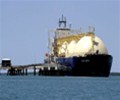

Liquefied natural gas (LNG) buyers are entering talks with sellers to lock in long-term contracts so they can avoid record-high spot prices but face rising offers amid tight supply forecasts, several sources familiar with the discussions said.
A synchronised global recovery in industrial activity after easing COVID-19 movement restrictions has boosted power demand while supplies of power generating fuels like natural gas and coal have been constrained, leading to output curbs and blackouts in parts of Asia and Europe in recent weeks.
Power providers have stepped up spot market purchases to bridge the supply gap, driving Asian spot LNG prices LNG-AS to a record of above $56 per million British thermal units (mmBtu) earlier this month. Prices have pulled back to around $30 per mmBtu since, but remain nearly 500% up from last year.
After shunning long-term deals when spot prices dropped to a record low of below $2 per mmBtu last year at the height of pandemic-induced lockdowns which hammered gas demand, buyers are now back in discussions, the sources said.
At the forefront of these discussions are buyers from China, the sources said. The country has overtaken Japan this year as the world’s top buyer of LNG.
“In the face of skyrocketing spot LNG prices, buyers appear to be increasingly anxious about availability of winter supplies and fearful of even higher spot prices,” said Valery Chow, head of Asia gas and LNG research at Wood Mackenzie.
“This is compounding concerns around growing market tightness over the first half of this decade, prompting national reassessments of energy security and the need to hedge against future price volatility.”
Global spot and short-term LNG contracts now account for over 40% of overall volumes, doubling in the last decade with purchases rising to over 140 million tonnes last year, partly as a result of Asian buyers hesitating to make long-term commitments amid energy transition uncertainties and growing supply liquidity, WoodMac’s Chow said.
So far, 24 million tonnes per annum (mtpa) of long-term LNG contracts have been signed into end-user markets this year, similar to 2018/2019 levels and up from a decade-long low last year, according to WoodMac.
At least five Chinese firms are in discussions with U.S. exporters to secure long-term cargoes, Reuters reported on Oct. 15. Last week, privately controlled ENN Natural Gas Co announced a 13-year deal with Cheniere Energy LNG.A, the first major deal between both countries after a trade war temporarily halted gas flow.
Indian buyers are also back in discussions to seal long-term contracts, said one of the sources familiar with the discussions, a Singapore-based industry participant.
While the buyers are entering the long-term contracts to fix lower prices, the outlook for tighter supply has prompted sellers to raise their offers, the sources said.
Sellers are unwilling to agree to any deal below a 12% slope of current Brent crude oil futures prices, compared with the just over 10% slope in deals earlier this year, they said.
LNG contract prices are typically expressed as a slope, or percentage, of Brent prices.
For example, a 12% slope of the current front-month Brent price of $84.74 a barrel would translate to LNG price of roughly$10.17 per mmBtu, though the contracts may not be that straightforward on pricing. That level would be well below current spot prices.
While spot prices could dip next year, prices are expected to remain strong over the next five years as Asian LNG demand outpaces global LNG supply growth, Woodmac’s senior research analyst Dan Toleman said.
Source: Reuters (Reporting by Jessica Jaganathan; Editing by Christian Schmollinger)